
Original Link: https://www.anandtech.com/show/18897/asrock-z790-taichi-carrara-motherboard-review
ASRock Z790 Taichi Carrara Motherboard Review: ASRock Rocks With White Marble
by Gavin Bonshor on August 2, 2023 9:00 AM EST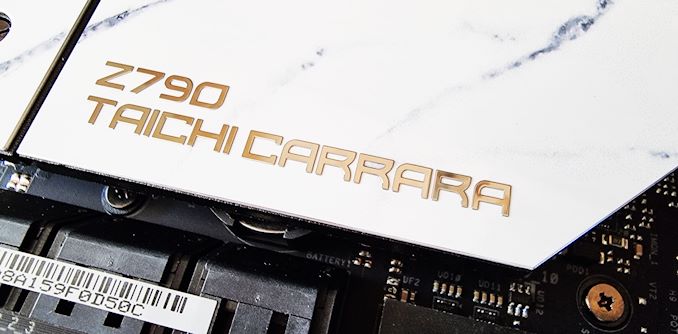
Building on the success of their hybrid architecture Alder Lake (12th Gen) Core series chips, Intel last year released the upgraded Raptor Lake core with a similar core architecture and design with performance (P) cores and efficiency (E) cores. While we've reviewed and put Intel's 13th Gen Core series chips through their paces, it's been a while since we tested out the platforms that not only unleash that multi-threaded and single-core IPC performance but add all of the features associated with each chipset. In a series of relative socket LGA 17000 motherboard reviews, we're looking at perhaps one of the most interesting models for Intel's 13th Gen Core series.
ASRock has added 'Carrara' to the mix, adding to their already popular Taichi series of motherboards that blend cogwheel-inspired aesthetics with a premium selection of controllers and features. Sometimes referred to as Luna marble by the Romans, the ASRock Z790 Taichi Carrara edition boasts a white Carrara marble-inspired design while retaining all the exact specifications and features of the regular Z790 Taichi. Some of the most prominent features include an advertised 27-phase (24+1+2) power delivery, support for DDR5-7400 memory, as well as dual Thunderbolt 4 Type-C ports on the rear panel.
ASRock loves to be different with its offerings, aka the Aqua series of motherboards. Still, the Taichi Carrara is different in that it celebrates ASRock's 20th anniversary at the upper echelon of PC components and hardware. We take a closer look to see if the Z790 Taichi Carrara's premium standing in ASRock's Z790 line-up represents what we've come to like about the Taichi series over the years and, more importantly, how it performs against other LGA 1700 motherboards.
ASRock Z790 Taichi Carrara Overview
As we've mentioned over the years, ASRock's Taichi series is perhaps its most notable, surpassing the brand recognition that their licensing deal with Johnathan "Fatal1ty" Wendel had with its Fatal1ty-inspired gaming designs back in the day. The ASRock Z790 Taichi Carrara edition builds upon the successful Taichi series. The Carrara portion of the naming represents the elegant white marble-inspired finish across the board's rear I/O panel, PCIe armor, and heatsinks, effectively replacing all the typical cogwheels and whatnot.
The Z790 Taichi Carrara, as it stands, is ASRock's current Z790 flagship, meaning it's their most premium model and comes with many features. Of all the ASRock LGA 1700 motherboards that support the 13th Gen and 12th Gen Core series chips, the ASRock Z690 Aqua is technically the brand's main flagship and halo model. That's certainly apparent in the Taichi series, which bridges the gap between the more mid-range models, such as the Z790 LiveMixer (review coming soon), with the Z690 Aqua. As Z790 is more of a refresh than a new platform, it's understandable why ASRock hasn't launched another Aqua model.
Taking a closer look at the ASRock Z790 Taichi Carrara, the most prominent feature of the aesthetics is the white Carrara marbled finish across the rear IO and audio PCB covers, as well as the chipset and the M.2 heatsinks. It is a striking yet elegant look, and it's very different from what's currently on the market. As such, ASRock also includes a 120 cm Carrara finished fan for users to install as a rear exhaust fan, and it also helps with matching components up to complete the look, which may be challenging to do. ASRock replaces the cogwheels with a white Carrara marbling finish. Although it's very different from the unique Taichi series we've come to like over the years, the Z790 Taichi Carrara certainly is unique.
In the top right-hand corner are four memory slots with support for up to DDR5-7400+ memory, although this is only for 1DPC with 1R, with users planning to use higher density kits in 2R likely to encounter lower speeds. ASRock's official specifications state that supports users with 1DPC with 2R and 2DPC 1R can support up to DDR5-6000, while users with 2DPC 2R are only able to support DDR5-4800.
Regarding PCIe support, two full-length PCIe 5.0 slots can operate at x16/x0 and x8/x8, with a full-length PCIe 4.0 x4 slot at the bottom. Storage support consists of one PCIe 5.0 x4 M.2 slot for the latest and greatest high-performance SSDs, while there are also a further four PCIe 4.0 x4 M.2 SSDs. At the bottom right-hand side of the board are eight SATA ports with support for RAID 0, 1, 5, and 10 arrays.
Along the bottom of the board is a selection of front panel headers, a two-digit LED debugger, a clear CMOS switch, and a power and reset button. For cooling, ASRock has 8 x 4-pin headers, one for a CPU fan, an optional CPU fan header that doubles up as a water pump header, and six regular 4-pin headers for chassis fans. While the rear panel has dual Thunderbolt 4 Type-C ports, ASRock includes one USB 3.2 G2x2 Type-C header for users with compatible chassis.
The power delivery used on the Z790 Taichi Carrara has a pretty beefy setup with premium components. Starting with the controller, ASRock is using a digital double output 20-phase capable PWM controller with 24 x Renesas RAA22010540 105 A smart power stages driving power to the processor, which gives the CPU up to a maximum of 2520 A and is very overkill for a board of this caliber. The onboard VCCGT voltage is a second Renesas RAA229131 PWM controller with one Renesas RAA2201054 105 A power stage accompanying it. Providing power to the power delivery and, thus, the CPU is a pair of 8-pin 12 V ATX power connectors.
Keeping the power delivery cool is a large pair of heatsinks interconnected via a single heatpipe. Even the rear IO shroud provides additional cooling capabilities as it's molded onto the larger of the two heatsinks. The ASRock Z790 Taichi Carrara (and the regular Taichi) power delivery heatsink is actively cooled, with two small 40 mm fans housed within the larger of the two heatsinks. It should theoretically prove more fruitful than a passively cooled VRM heatsink.
A thin metal Carrara marbled cover covers the audio section of the PCB. Spearheading the Z790 Taichi Carrara's audio capabilities is a Realtek ALC4082 HD audio codec, with an assist going to an ESS Sabre 9218 DAC designed to bolster headphone capabilities. The rear panel has just two 3.5 mm audio jacks and S/PDIF instead of the usual five 3.5 mm audio jacks, so there's not much else going on. However, ASRock has used four red WIMA audio capacitors, which look better than the typical golden Japanese audio capacitors.
On the rear panel of the ASRock Z790 Taichi Carrara is a pair of Thunderbolt 4 Type-C ports that serve as a 40 Gbps capable transfer connection from compatible devices and double up as video outputs. ASRock has included a conventional HDMI 2.1 video output. At the same time, the onboard audio powered by the Realtek ALC4082 HD audio codec and ESS Sabre 9218 DAC provides two 3.5 mm audio jacks and a single S/PDIF optical output. There are also six USB 3.2 G2 (10 Gbps) Type-A ports and two USB 2.0 ports. The networking capabilities include one Killer E3100G 2.5 GbE, one Intel I219V Gigabit port, and a Killer AX1690 Wi-Fi 6E CNVi, providing wireless and BT 5.3 support.
With the white Carrara marbled aesthetic, the ASRock Z790 Taichi Carrara is undoubtedly a unique addition to the many Z790 motherboards currently available. It's also a welcomed addition to the Taichi series as it not only adds a new dynamic to the existing RGB-clad cogwheel-inspired design but with the same feature and controller set as the regular Taichi, it's a solid mid to high-range Z790 motherboard. At launch, it had an MSRP of around $499. Most sites that do stock it (when they have it) retail it for between $499 and $520, with Scan Computers having it for £550 at the time of writing. The ASRock Z790 Taichi Carrara is a reasonable proposition on paper, and it even has an actively cooled VRM, which is also rare nowadays, adding another area that allows it to stand out from other Z790 motherboards.
Of course, the performance is the most crucial element besides the feature set, so read on for our extended analysis.
BIOS
The ASRock UEFI firmware is something we've seen numerous times over the last few years, and not much has changed in terms of the GUI design, the overall look, and the organization of the menus. Much like other Intel-based motherboards from ASRock's product ranges, the only thing that tends to change is the design's color scheme. The ASRock Z790 Taichi Carrara firmware uses a very similar BIOS to the OC Formula series, with yellow and white text, a light grey highlight on the selected option, and a predominately black background.
The ASRock Z790 Taichi Carrara has two primary modes within the BIOS; easy and advanced. In the 'easy' mode is an essential list of information about the installed processor, memory, and fan speeds. Users can access ASRock's FAN-Tastic fan tuning utility and Instant Flash modes to update the latest firmware. At the same time, users can toggle Intel's base power limit, change the boot priority, and change the language used throughout the BIOS.
All of the core features of the Z790 chipset, as well as the overclocking and tweaking options, can be found within the 'advanced' mode. This can be accessed by pressing the F6 key, which cycles between both modes. As we've seen with ASRock's firmware, ASRock separates the CPU, voltage, and memory options into different sections within the OC Tweaker section. Overclocking the CPU with the Z790 Taichi Carrara is as easy as other vendors' UEFI firmware. However, we recommend that only experienced users or those with overclocking knowledge touch these settings.
There are plenty of options to overclock the CPU, whether simply adjusting the frequency on the P and E cores, voltage changes, or finer tuning of Intel's overclocking features, such as Thermal Velocity Boost and per-core customizations. Users can access multiple avenues of overclocking their components, with extensive memory tuning options on offer and the ability to enable memory profiles with a simple click; the Z790 Taichi Carrara firmware recognizes both XMP and AMD's EXPO profiles.
Overall the ASRock Z790 Taichi Carrara firmware is intuitive, easy to navigate, and offers plenty of options for users to customize various settings that can alter system performance. One thing we're not entirely sold on is the GUI. With models such as the Z790 LiveMixer, which we will review over the coming weeks, ASRock used a themed GUI that added exclusivity and flair. The Carrara is just using ASRock's base firmware design. Although it seems picky to highlight this, we believe a special edition motherboard with such a unique look, such as the white Carrara marbled aesthetic, deserves a little more afterthought.
Software
Similar to ASRock's included software bundle, we've seen many of these programs and applications before, so not much has changed in this regard generationally. One thing to highlight is that like ASUS started doing on its ROG models in the last couple of generations, the ASRock Z790 Taichi Carrara has a pool of memory on the board, which includes networking drivers, which then does download the latest drivers for the board's controllers available from the applicable download server.
The central hub of ASRock's software bundle can be accessed from the ASRock Live Update and App Shop, which over the years, has evolved to combine two apps into one; Live Update and the App Shop. Here, users can update drivers and ASRock's software to the latest available versions, as well as download new applications such as A-Tuning, ASRock App Charger, ASRox XFast LAN, and even Norton 360 for Gamers, which is free to download.
Perhaps the most notable software from ASRock is their A-Tuning overclocking utility. Not only can users overclock their 13th or 12th Gen Core series processor within Windows with this software, but it also provides direct access to ASRock's FAN-Tastic Tuning utility. Users can set custom fan profiles on each installed fan (up to 8) or sync them together for quiet or full-speed operation.
While the A-Tuning utility is handy to have, Intel also has their Extreme Tuning Utility (XTU), much like AMD has their own called Ryzen Master. I feel that XTU offers more settings and scope to do overclocking within Windows, but for users unfamiliar with XTU, A-Tuning serves a purpose. As I've always said for as long as I can remember, I prefer to overclock in the BIOS, which hasn't changed.
Overall, ASRock does offer plenty within their software bundle, including their XFast LAN for those who prefer to do traffic shaping, or the ASRock Polychrome RGB software for those who want to customize the integrated RGB LEDs on the board, as well as sync up with other components such as RGB-enabled DRAM and peripherals. It's not the most monolithic of software bundles, but there's plenty for users to sink their teeth into.
Board Features
The ASRock Z790 Taichi Carrara is a mid-range to high-end E-ATX motherboard, which bridges the gap between ASRock's Steel Legend and Phantom Gaming series with the halo ASRock Z690 Aqua. The Taichi series in itself is a premium range of motherboards, whereas the Z790 Taichi Carrara has the same feature set as the regular Taichi; it is different with its white Carrara marbled styled aesthetics.
As a premium LGA1700 motherboard designed for Intel's 13th Gen and 12th Gen Core series processors, it does support PCIe 5.0, with two full-length PCIe 5.0 slots that can operate at x16/x0 or x8/x8, while ASRock includes a single full-length PCIe 4.0 x4 slot which is driven by the Z790 chipset. There are four memory slots with support for up to and including DDR5-7400 memory, and they can accommodate a maximum of 192 GB.
Regarding cooling support, there are 8 x 4-pin fan headers, with one specifically for a CPU fan, one acting as an optional CPU fan and water pump, and six 4-pin headers for chassis fans, although all the headers can support water cooling pumps.
| ASRock Z790 Taichi Carrara Motherboard | |||
| Warranty Period | 3 Years | ||
| Product Page | Link | ||
| Price (MSRP/Amazon) | $499 | ||
| Size | E-ATX | ||
| CPU Interface | LGA1700 | ||
| Chipset | Intel Z790 | ||
| Memory Slots (DDR4) | Four DDR5 Supporting 192 GB Dual-Channel Up to DDR5-7400+ OC (1R+1DPC) |
||
| Video Outputs | 1 x HDMI 2.1 2 x Thunderbolt 4 (Type-C) |
||
| Network Connectivity | 1 x Killer E3100G 2.5 GbE 1 x Intel I219-V Gigabit Killer AX1690 Wi-Fi 6E |
||
| Onboard Audio | Realtek ALC4082 ESS Sabre 9218 DAC |
||
| PCIe Slots for Graphics (from CPU) | 2 x PCIe 5.0 x16 (x16/x0, x8/x8) | ||
| PCIe Slots for Other (from PCH) | 1 x PCIe 4.0 (x4) | ||
| Onboard SATA | Eight, RAID 0/1/5/10 | ||
| Onboard M.2 | 1 x PCIe 5.0 x4 4 x PCIe 4.0 x4 |
||
| Onboard U.2 | N/A | ||
| Thunderbolt 4 (40 Gbps) | 2 x Type-C | ||
| USB 3.2 (20 Gbps) | 1 x USB Type-C (Front panel) | ||
| USB 3.2 (10 Gbps) | 2 x USB Type-A (Rear panel) | ||
| USB 3.2 (5 Gbps) | 6 x USB Type-A (Rear panel) 4 x USB Type-A (Two headers) |
||
| USB 2.0 | 2 x USB Type-A (Rear panel) 4 x USB Type-A (Two headers) |
||
| Power Connectors | 1 x 24-pin Motherboard 2 x 8-pin CPU 1 x 6-pin for Fast Charging |
||
| Fan Headers | 1 x 4-pin CPU 1 x 4-pin Water pump 6 x 4-pin Chassis |
||
| IO Panel | 2 x Antenna Ports (Killer) 2 x Thunderbolt 4 Type-C 6 x USB 3.2 G2 Type-A 2 x USB 2.0 Type-A 1 x RJ45 (Killer) 1 x HDMI 2.1 Output 2 x 3.5 mm Audio jacks (Realtek) 1 x S/PDIF Optical output (Realtek) |
||
In terms of storage, the ASRock Z790 Taichi has one PCIe 5.0 x4 M.2 slot, with four PCIe 4.0 x4 M.2 slots, and eight SATA ports; all of the SATA ports can support RAID 0, 1, 5, and 10 arrays. On the rear panel, ASRock includes plenty of connectivity, including dual Thunderbolt 4 Type-C ports, which can double up as video outputs for additional and compatible monitors. For conventional monitors, there is one HDMI 2.1 video output. ASRock also includes six USB 3.2 G2 Type-A ports and two USB 2.0 ports, while a USB 3.2 G2x2 10 Gbps header is available to use for chassis with a compatible front panel.
The ASRock Z790 Taichi Carrara has a decent networking array, including two Ethernet ports, one controlled by a Killer E3100 2.5 GbE controller and the other by an Intel I219-V Gigabit controller. For wireless, ASRock includes a Killer AX1690 Wi-Fi 6E CNVi with support for wireless and BT 5.3 connectivity.
In keeping in line with other mid-range to premium Z790 motherboards, ASRock has a decent on-board audio configuration with a Realtek ALC4082 HD audio codec doing much of the audio processing, with an assisting ESS Sabre 9218 DAC providing an uprated experience for users with good quality headphones. As such, ASRock offers just two 3.5 mm audio jacks and a single S/PDIF optical output.
Test Bed
With some of the nuances with Intel's Raptor Lake processors, including the use of P and E-cores, our policy is to see if the system gives an automatic option to increase the power limits of the processor. If it does, we select the liquid cooling option. If it does not, we do not change the defaults.
| Test Setup | |||
| Processor | Intel Core i9-13900K, 125 W, $589 8P + 16E Cores, 24 Threads 3.0 GHz (5.8 GHz P-Core Turbo) |
||
| Motherboard | ASRock Z790 Taichi Carrara (BIOS 7.04) | ||
| Cooling | EKWB EK-AIO Elite 360 D-RGB 360mm | ||
| Power Supply | Corsair HX850 80Plus Platinum 850 W | ||
| Memory | Corsair Dominator Platinum RGB DDR5-6000 CL30 (2 x 16 GB) | ||
| Video Card | AMD Radeon RX 6940 XT, 31.0.12019 | ||
| Hard Drive | SK Hynix Platinum P41 2TB PCIe 4.0 | ||
| Case | Open Benchtable OBT V2 | ||
| Operating System | Windows 11 22H2 | ||
We must also thank the following:
System Performance
Not all motherboards are created equal. On the face of it, they should all perform the same and differ only in the functionality they provide - however, this is not the case. The obvious pointers are power consumption, POST time and latency. This can come down to the manufacturing process and prowess, so these are tested.
For Z790 we are running using Windows 11 64-bit with the 22H2 update.
Power Consumption
In previous motherboard reviews, we focused on the overall system power, and while sometimes useful, it doesn't paint the full picture. Motherboards can vary in power, but users with more M.2 SSDs, more devices plugged into the motherboard, and additional PCIe devices such as capture cards or sound cards will experience variances in power consumption.
For our motherboard reviews going forward, we're going to be focusing on power draw explicitly from the CPU, as in real-world situations, the processor is the de-facto part of the system that will display variance in power; the graphics card will also draw power, but with so many different models of the graphics card, these values will vary massively. To capture CPU power draw from each motherboard tested, we will be using ElmorLabs PMD-USB power measurement device, which directly plugs into the 8-pin ATX EPS 12 V CPU power connectors, and lets us directly measure the power being fed into the CPU via the power delivery from the power supply.
Ideally, lower values are better, especially with Intel's 13th and 12th Gen Core processors. The other factor is, of course, performance, which goes hand in hand with power consumption depending on the workload and the amount of CPU processing being utilized on the cores. At idle, the lower value is best, but some motherboard vendors are more aggressive on voltages, and more voltage = more heat and higher power consumption.
At idle values, we are measuring the value while the system has settled down, and for load power, we're measuring the average peak value over the course of the 10-minute CB23 MT run. This is because while power-hungry at full-load, processors can sometimes spike for a second or two and as such, can skew peak results, hence why we take the average value.


Looking at CPU package power when used with our Intel Core i9-13900K, we can see at both idle and full-load, the ASRock Z790 Taichi Carrara pulls more watts than other LGA 1700 motherboards we've tested so far. At idle, we measured 5.5 W, which was just over a watt higher than other boards.
Looking at the full-load average, the Z790 Taichi Carrara was over 10 W higher on average than the next board on the list, the MSI Z790 Carbon WIFI. While not a massive different at full load, it looks as though ASRock is being more aggressive with CPU voltage and power at full-load.
Non-UEFI POST Time
Different motherboards have different POST sequences before an operating system is initialized. A lot of this depends on the board itself, and POST boot time is determined by the controllers on board (and the sequence of how those extras are organized). We look at the POST Boot Time using a stopwatch as part of our testing. This is the time from pressing the ON button on the computer to when Windows starts loading. (We discount Windows loading as it is highly variable given Windows-specific features.)

Using our regular method to measure POST time, the Z790 Taichi Carrara took noticeably longer than other boards on test, which all bar the Taichi managed to boot in under 23 seconds. The Z790 Taichi Carrara, on the other hand, was over 8 seconds slower than the next slowest board, the GIGABYTE Z790 Aorus Xtreme.
DPC Latency
Deferred Procedure Call latency is a way in which Windows handles interrupt servicing. In order to wait for a processor to acknowledge the request, the system will queue all interrupt requests by priority. Critical interrupts will be handled as soon as possible, whereas lesser priority requests such as audio will be further down the line. If the audio device requires data, it will have to wait until the request is processed before the buffer is filled.
If the device drivers of higher priority components in a system are poorly implemented, this can cause delays in request scheduling and process time. This can lead to an empty audio buffer and characteristic audible pauses, pops, and clicks. The DPC latency checker measures how much time is taken processing DPCs from driver invocation. The lower the value will result in better audio transfer at smaller buffer sizes. Results are measured in microseconds.

We measure DPC latency out of the box with no tweaks or refinement within Windows, and as we can see, the Z790 Taichi Carrara did best out of the LGA 1700 models we've tested with the Core i9-13900K so far.
CPU Performance, Short Form
For our motherboard reviews, we use our short form testing method. These tests usually focus on if a motherboard is using MultiCore Turbo (the feature used to have maximum turbo on at all times, giving a frequency advantage), or if there are slight gains to be had from tweaking the firmware. We put the memory settings at the CPU manufacturers suggested frequency, making it very easy to see which motherboards have MCT enabled by default.
For Z790 we are running using Windows 11 64-bit with the 22H2 update.
Rendering - Blender 3.5
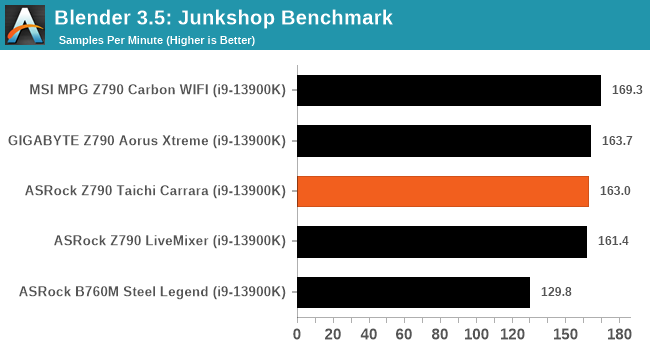
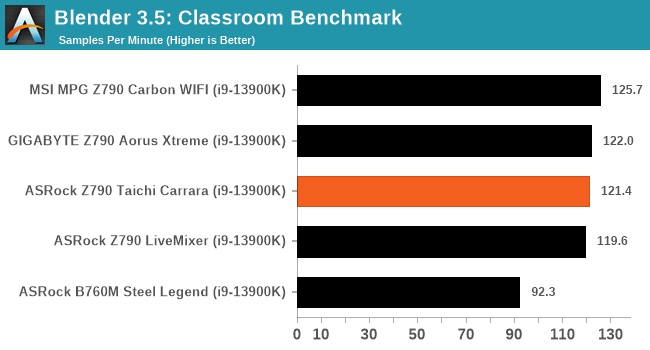
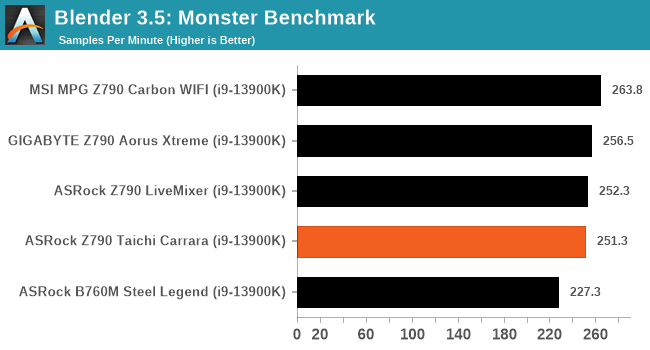
Rendering - Crysis CPU Render
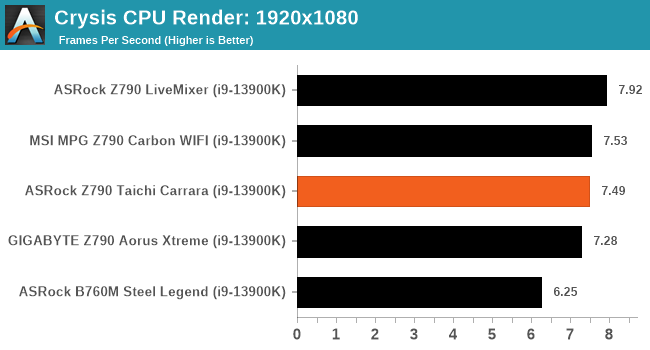
Rendering - Cinebench R23
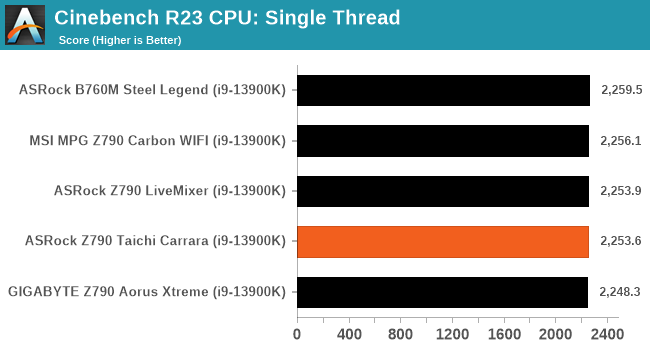
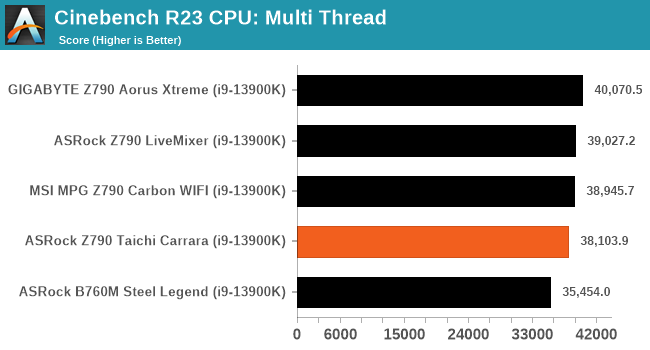
Synthetic - GeekBench 5
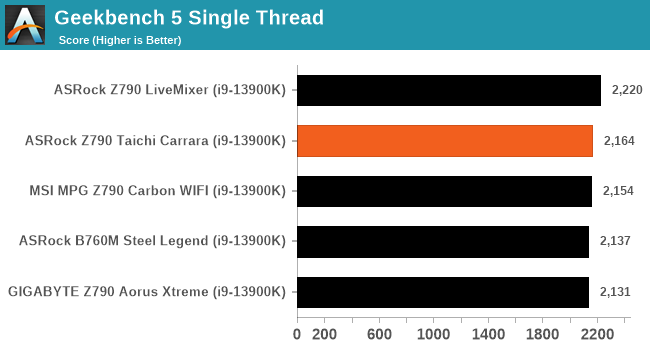

Compression – WinRAR 5.90
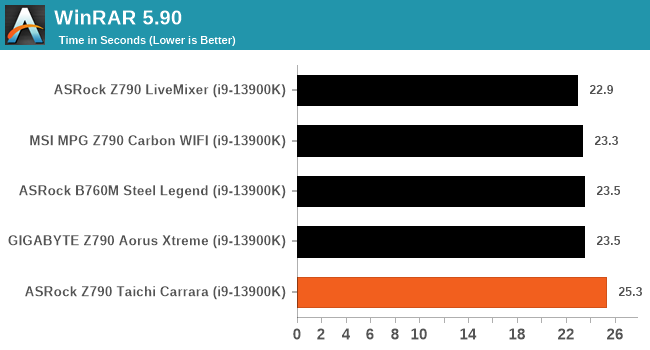
3D Movement Algorithm Test – 3DPMv2.1
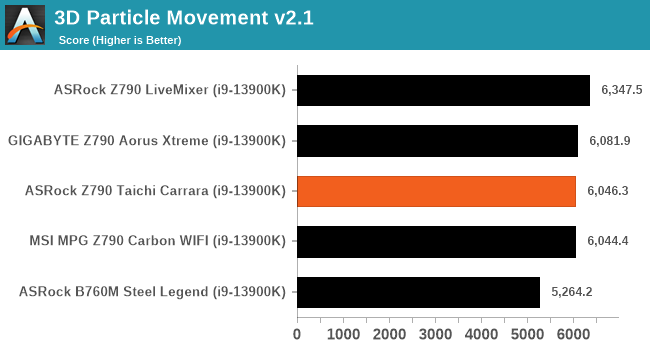
There wasn't too much difference between the boards in our compute performance section. The anomaly, the ASRock B760M Steel Legend is limited to fit within Intel's Power Limit by default and, as such, doesn't have as much power budget available as the Z790 boards do.
The Taichi Carrara was only around 4% slower on average in Blender 3.5. Still, a lot of the results showed competitive and negligible results, with the only questionable area in performance coming in WinRar 5.90, which was around 7% slower than the rest of the boards.
Gaming Performance
When it comes to testing motherboards, much of the performance between most of the boards tested with the same processor such as the Intel Core i9-13900K, is fairly similar. The main reason we're testing gaming performance in our motherboard reviews is to see if there are any anomalies. There are also occasions on platforms where some vendors will 'overcharge' performance by implementing Multi-Core Enhancement (MCE). This can alter performance far beyond what processor vendors such as AMD and Intel set as their default values.
For Z790 we are running using Windows 11 64-bit with the 22H2 update.
F1 2022: 1080p Ultra Settings
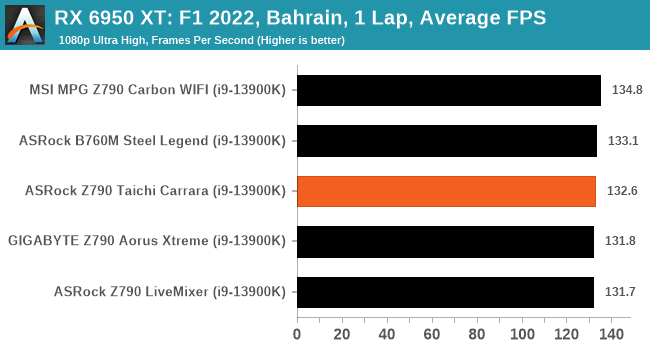
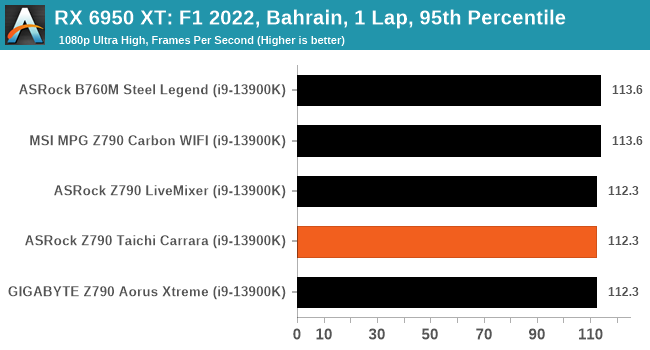
F1 2022: 4K High Settings
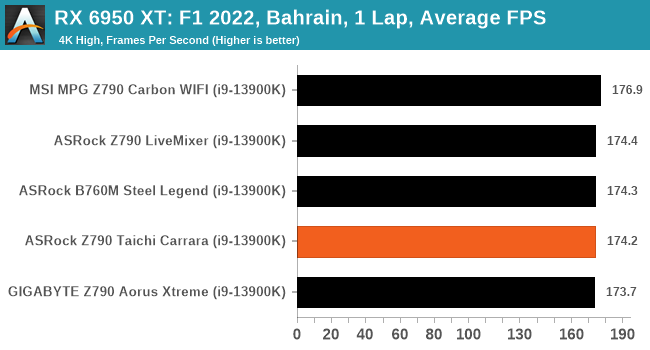
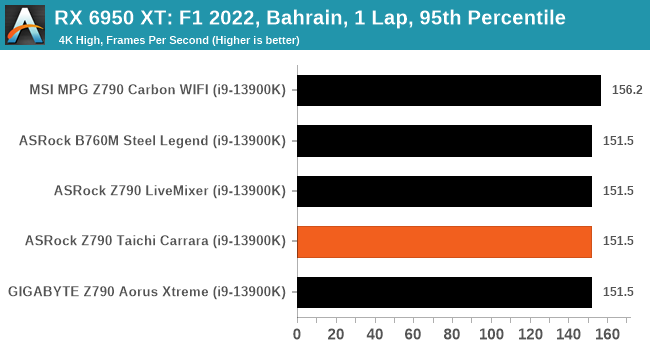
Total War: Warhammer 3: 1080p Ultra Settings

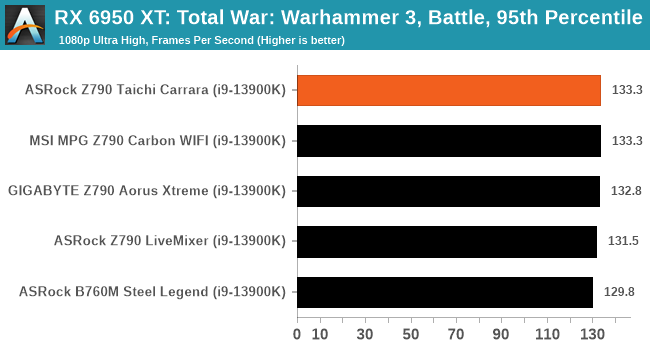
Total War: Warhammer 3: 4K High Settings
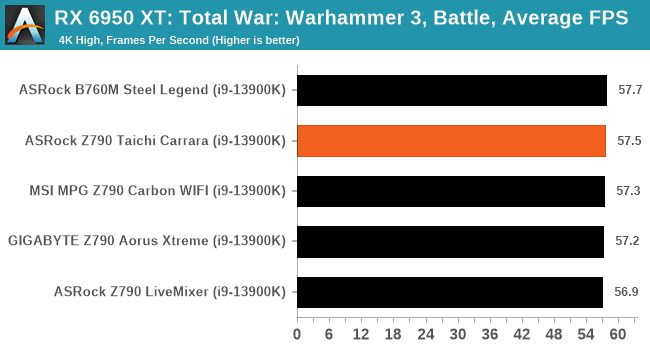
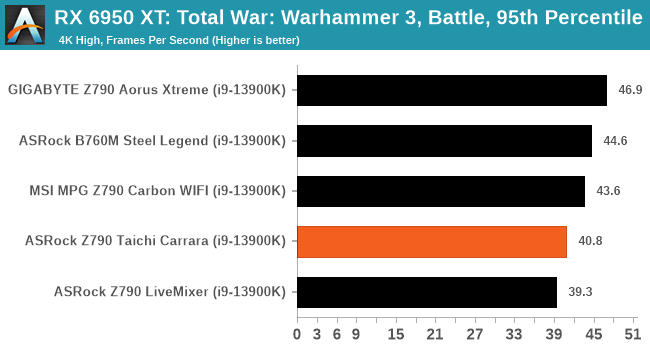
Looking at the gaming performance of the ASRock Z790 Taichi Carrara, its performance is similar to the rest of the LGA 1700 motherboards we've tested. The only anomaly we could see was in Total War: Warhammer 3 at 4K, where we saw lower than ideal 95th percentile frame rates, which in comparison, was around 13% slower than the GIGABYTE Z790 Aorus Xtreme.
Power Delivery Thermal Analysis
One of the most requested elements of our motherboard reviews revolves around the power delivery and its componentry. Aside from the quality of the components and its capability for overclocking to push out higher clock speeds which in turn improves performance, is the thermal capability of the cooling solutions implemented by manufacturers. While almost always fine for users running processors at default settings, the cooling capability of the VRMs isn't something that users should worry too much about, but for those looking to squeeze out extra performance from the CPU via overclocking, this puts extra pressure on the power delivery and in turn, generates extra heat.
Given how fast Intel and AMD's processors are at default turbo clock speeds, overclocking is becoming less and less relevant. Of course, a sub-section of the audience still likes to overclock, with some competition on the fabled HWBot competition platform. There are more models of motherboards than ever before, which often include fancy heatsinks on premium models with better cooling designs, heftier chunks of metal, and in some cases, even water blocks.

The 27-phase (24+1+2) power delivery on the ASRock Z790 Taichi Carrara
Testing Methodology
Our testing method is to determine whether the power delivery and heatsink effectively dissipate heat. We do this by running a realistic yet still heavy CPU workload for a prolonged period of time. While we previously applied a set overclock deemed safe. For Intel's Raptor Lake (13th Gen Core series), we're using Intel's Speed Optimizer (ISO 2.0) to determine the maximum clocks and voltages. We then run Cinebench R23 MT on a loop for an hour, putting a realistic and pressured load on the processor. We collect our data via three different methods, which include the following:
- Taking a thermal image from a birds-eye view after an hour with a Flir Pro thermal imaging camera
- Securing two probes onto the rear of the PCB, right underneath CPU VCore section of the power delivery for better parity in case a probe reports a faulty reading
- Taking a reading of the VRM temperature from the sensor reading within the HWInfo monitoring application
The reason for using three different methods is that some sensors can read inaccurate temperatures, which can give very erratic results for users looking to gauge whether an overclock is too much pressure for the power delivery handle. With using a probe on the rear, it can also show the efficiency of the power stages and heatsinks as a wide margin between the probe and sensor temperature can show that the heatsink is dissipating heat and that the design is working or that the internal sensor is massively wrong. To ensure our probe was accurate before testing, I binned 10 and selected the most accurate (within 1c of the actual temperature) for better parity in our testing.
For thermal imaging, we use a Flir One camera to indicate where the heat is generated around the socket area, as some designs use different configurations, and an evenly spread power delivery with good components will usually generate less heat. Manufacturers who use inefficient heatsinks and cheap out on power delivery components should run hotter than those who have invested. Of course, a $700 flagship motherboard will likely outperform a cheaper $100 model under the same testing conditions, but it is still worth testing to see which vendors are doing things correctly.
Thermal Analysis Results

We measured 74.2ºC on the hottest part of the CPU socket during our testing (ISO 2.0)
The Z790 Taichi Carrara has a very large power delivery, which ASRock advertises as a 24+1+2 design. While that is true when factoring in all of the power phases, including those for memory, the bulk of what's actually useful to the CPU is technically a 24+2 phase design. For the CPU section of the ASRock Z790 Taichi Carrara's power delivery are 24 x Renesas RAA2201540 105 A smart power states, with a Renesas RAA229131 PWM controller and an additional RAA2201054 105 A power stage doing all of the phase switching duties.
The ASRock Z790 Taichi Carrara and the regular Taichi are two examples of an active cooled VRM on the Z790 chipset. There is a large two-section heatsink interconnected with a single heatpipe, which actually has two small 40 mm cooling fans housed within the main body of the heatsink, which is designed to direct airflow over the fins and aid in dissipating heat.
Looking at our thermal VRM testing results, the Z790 Taichi Carrara is one of the cooler designs we've tested, with a maximum recorded temperature when applying Intel's Speed Optimizer settings of 70°C. It also has one of the lowest CPU V-Core when tested with the ISO 2.0 applied via Intel's overclocking software, called the Extreme Tuning Utility, or XTU for short.
This also segues us into our overclocking results, as given how fast Intel's Core i9-13900K is at default settings and how hot it operates, there's not much overclocking headroom available at all, even when using a premium 360 mm such as we are.
Overclocking Results
Focusing on the overclocking performance when using Intel's Speed Optimizer settings through XTU, we can see how each board performs in CineBench R23 MT and at what average CPU V-Core, peak package power, and the peak CPU package temp.
The ASRock Z790 Taichi Carrara at default settings in a 1-hour continuous run of CineBench R23 MT, we can see it has a peak average CPU V-Core of 1.376 V, with 22.1% more performance in CB23 MT than running at Intel's default PL1 and PL2 of 253 W. Using Intel's ISO 2.0 profile, the board only managed to pull an additional 1.4% of performance in CB23 MT, but with 5°C higher on average on the CPU temperature, with around 18 W more watts on average.
Not only has Intel squeezed a lot of performance from the silicon with their high default turbo clock speeds, but the ASRock Z790 Taichi Carrara allows the chip to maintain this performance over a prolonged period of time. It is worth noting that the Core i9-13900K is a very hot running chip, especially at full load, and premium cooling is a requirement in working alongside Intel's Thermal Velocity Boost (TVB) technology; lesser cooling means lower performance due to the chip being clipped back in frequency once it hits 80c.
The ASRock Z790 Taichi Carrara also has a very good power delivery. As such, if users did want to overclock further and intended to use premium cooling such as custom water cooling, then depending on the quality of the silicon itself, users shouldn't have any problems in pushing the chip even further. It's worth noting that on Raptor Lake (Intel's 13th Gen Core), temperatures are the biggest issue in limiting overclocking potential.
Conclusion
When buying a motherboard to use with Intel's 13th or 12th Gen Core series of processors, there's a wide variety of choices. Being on Intel's LGA 1700 socket, multiple chipset options are available to users, with Intel's 600-series models, such as Z690, also supporting both platforms. The latest and most current is the Z790 chipset, which is very similar to Z690 in specifications, with the only differences coming in connectivity and memory support. The Z790 chipset can accommodate one extra USB 3.2 G2x2 Type-C port and supports up to DDR5-5600B, and that's it. While hardly a reason to create a new chipset, it does allow motherboard vendors to release a wave of new motherboards, including ASRock with the Z790 Taichi Carrara edition.
In what is considered a direct sidestep to ASRock's Z790 Taichi, the Z790 Carrara Taichi shares the same specifications, including support for up to DDR5-7400 (OC) memory, dual Thunderbolt 4 Type-C ports, 2.5 GbE, and Wi-Fi 6E, the difference comes in aesthetic. The ASRock Z790 Taichi Carrara features a striking white Carrara marbled-inspired design, a unique twist on the Taichi design but a very welcome one. Dropping all of the RGB-enabled cogwheels and multitudes of black and greys, the Carrara Taichi uses a white marbling across the entirety of the board, including the rear panel, the M.2 heatsinks, and the chipset heatsink. It looks elegant, but users may have problems finding hardware to match the aesthetic. Despite that, it's a stunning-looking motherboard.
Touching on the finer specifications, for storage, ASRock includes one PCIe 5.0 x4 M.2 slot for the latest and fast-running Gen 5 NVMe drives, as well as four PCIe 4.0 x4 M.2 slots and eight SATA ports capable of supporting RAID 0, 1, 5, and 10 arrays. Connectivity options are impressive, including two premium Thunderbolt 4 Type-C ports on the rear panel, two additional USB 3.2 G2 Type-A ports, six USB 3.2 G1 Type-A ports, and two USB 2.0 ports. That gives the Z790 Taichi Carrara twelve connectors on the rear panel alone, with one USB 3.2 G2x2 Type-C, four USB 3.2 G1 Type-A, and four USB 2.0 ports available through front panel headers.
That's a good level of connectivity, even for a motherboard filling the gap between the regular models such as their Z790 Steel Legend and Phantom Gaming models and the flagship halo level Z690 Aqua motherboard. Regarding networking, the Z790 Taichi Carrara is spearheaded by a Killer E3100G 2.5 GbE and Intel I219-V Gigabit NIC pairing. At the same time, ASRock also includes a Killer AX1690 Wi-Fi 6E CNVi, which supports the latest BT 5.3 devices.
Focusing on performance, the ASRock Z790 Taichi Carrara is competitive. Although we did experience slower-than-expected POST times into Windows, the flipside is that the DPC latency performance out of the box is the best we've tested on Z790. Other performance areas, including those all-important VRM thermals, were also competitive. Although ASRock includes an actively cooled VRM heatsink with two 40 mm fans assisting, it wasn't the coolest design we've tested. Using Intel's ISO 2.0 profile via the Extreme Tuning Utility (Intel XTU), we hit up to 70°C on the VRM, and with a sizeable 24+2-phase power delivery, we must admit that we were expecting cooler temperatures. The results still fit well within the rated specification of the components, so that's not overly negative.
Final Words: Carrara White Marbled Elegance, But Could Offer More
The ASRock Z790 Taichi Carrara at $499 is a solid E-ATX motherboard with competitive performance, sizeable over-engineered power delivery, and stylish aesthetics. That being said, there are areas of improvement, most notably in the networking configuration. The only area where ASRock could have offered more is networking connectivity.
For a $499 motherboard, ASRock could have done more here, as even the GIGABYTE Z790 Aorus Master ($490) comes with a 10 GbE controller, and the ASUS ProArt Z790-Creator WIFI ($420) has 10 GbE, 2.5 GBe, and Wi-Fi 6E too. At the price point, ASRock has seemingly traded uprated networking for dual Thunderbolt 4 Type-C ports, which comes down to what users want most from a motherboard. Other models of a similar ilk include the MSI MPG Z790 Carbon WiFi ($480) and the ASUS ROG Strix Z790-E Gaming WIFI 6E ($500), which all have similar specifications. The only pitfall to the Z790 Taichi Carrara is the availability, which given its a special edition model, maybe a little more challenging to get hold of. There are retailers with stock every so often, including in the US and UK, most notably Scan Computers for £550.
There's no board like the ASRock Z790 Taichi Carrara from a design point of view. For users who like the white Carrara marbled aesthetic, the Z790 Taichi Carrara is a decent example of a premium Intel LGA 1700 motherboard with all the main boxes being ticked. With better networking capabilities, it would have probably been one of the best sub $500 motherboards on the market. Despite that, the ASRock Z790 Taichi Carrara is a unique Z790 motherboard that offers a more stylish (in our opinion) alternative to the slightly cheaper Z790 Taichi ($480).
With BIOS's already being rolled out to support the upcoming 14th Gen Core series, it makes models such as the ASRock Z790 Taichi Carrara even more desirable, unless, of course, ASRock releases a new and 'better' variant in the coming months, as most motherboard vendors typically do for an Intel processor launch.


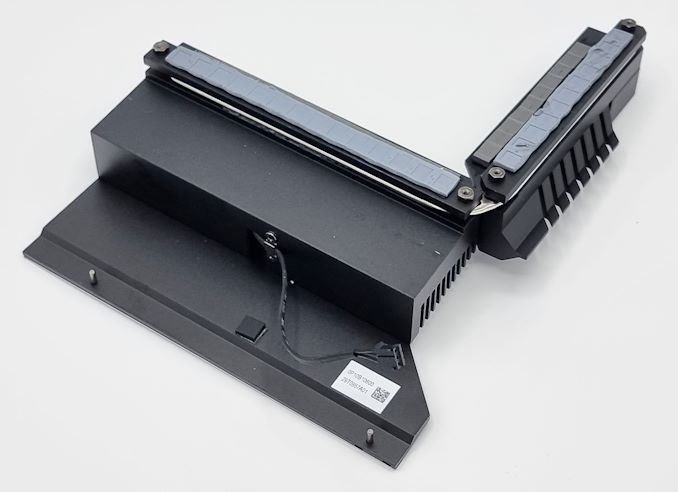
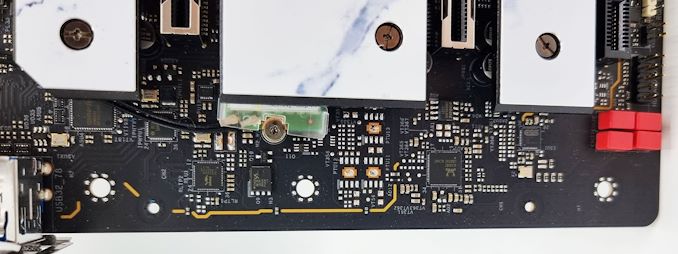
_575px.jpg)
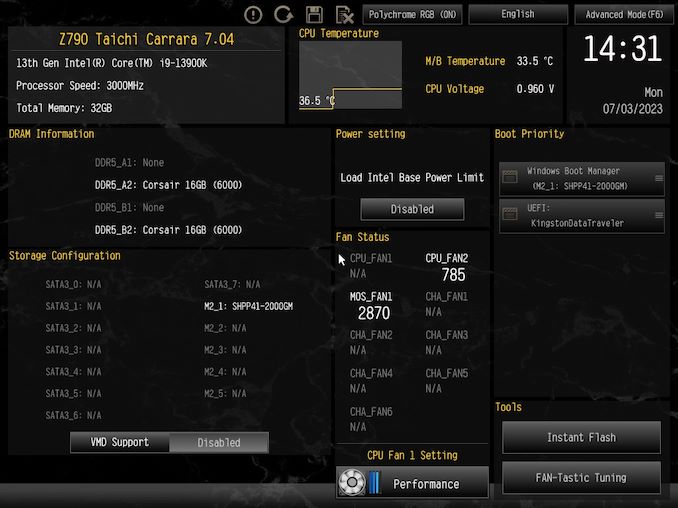







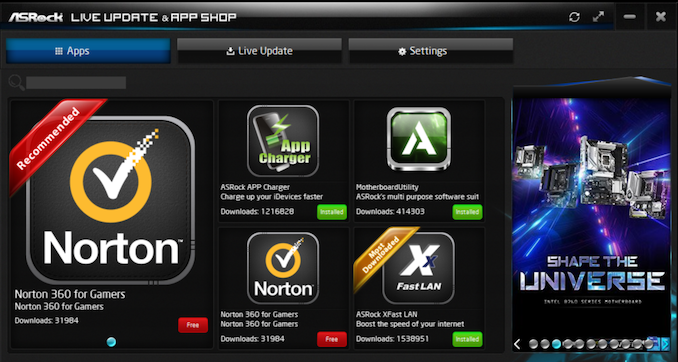
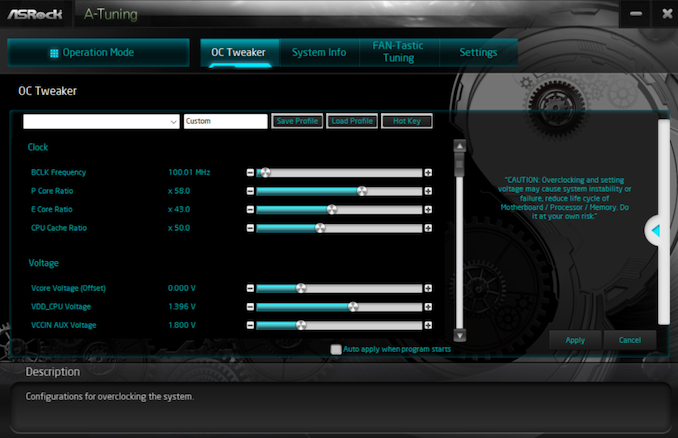






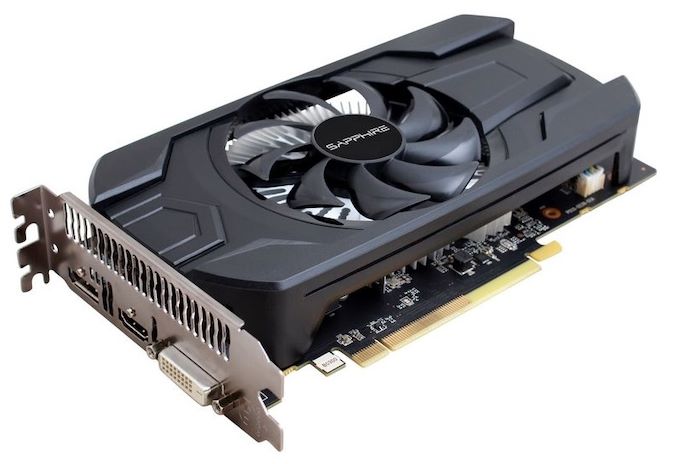
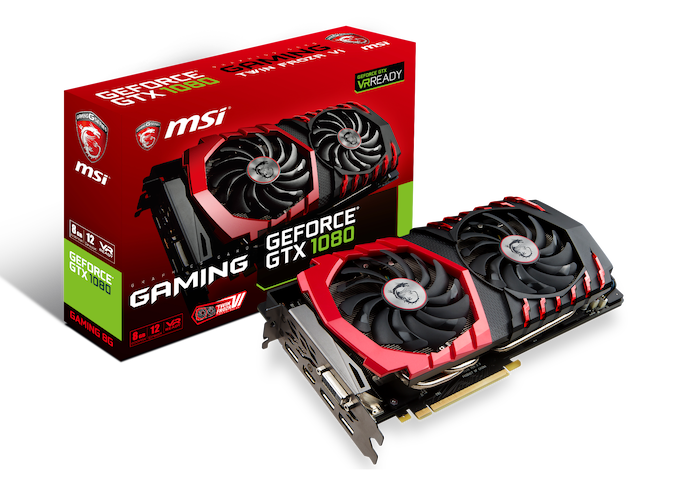
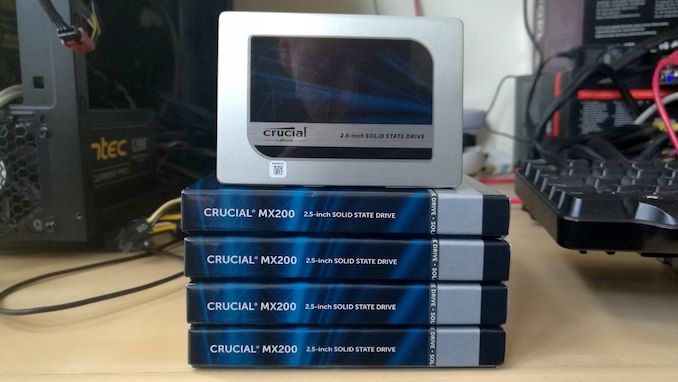
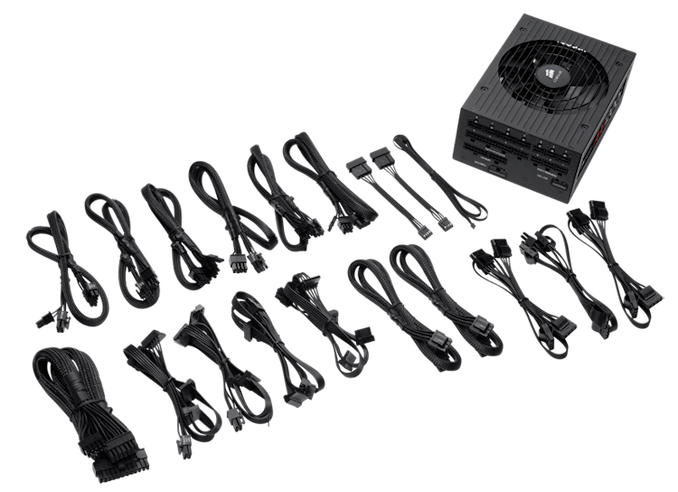
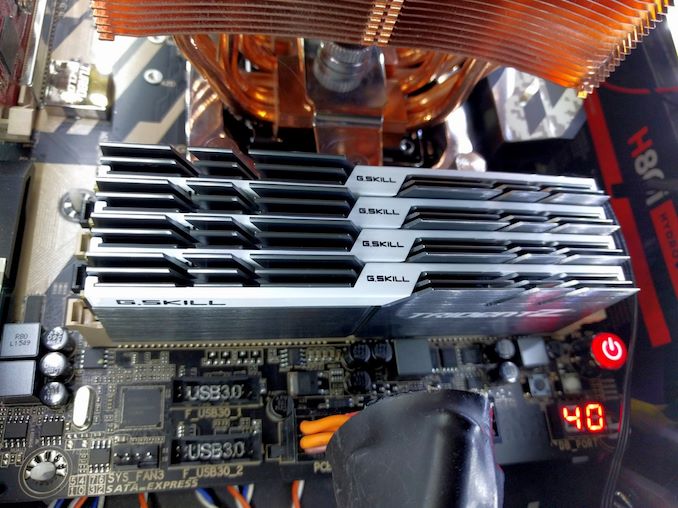
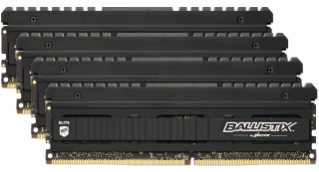

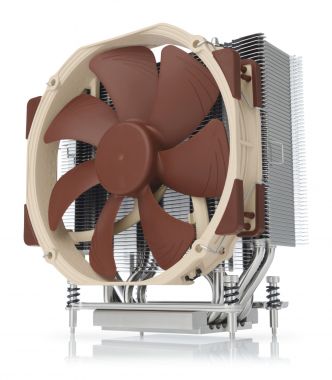


_575px.jpg)






